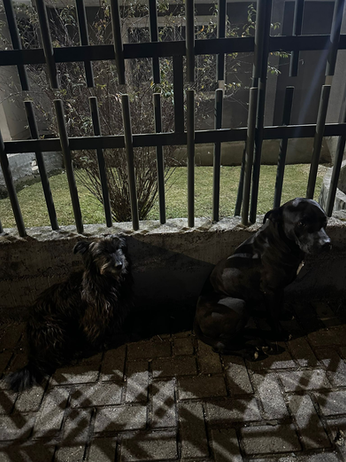
Summer Undergraduate International Research Experience

.png)
Week 8
-
This week was interesting. I kept on doing my micro CT analysis in the lab, trying to get as much done as possible. Throughout the week I pet many stray animals under different cirmcunstances (as you may see in the pictures).
Everything went wrong?
CT scans are fine. CT scans analysis using free programs on a really old computer are not fun. After coming to the conclusion that it would be essentially impossible to discern the apodeme from muscles in the scans, I had to segment a few other legs to see whether I could use the muscle, if it was not damaged. Segmenting the muscles took a long time in some legs, since I had to most of the time, check frame for frame of the images to accurately separate cuticle from the muscle, which tend to show up in the same intensity. The legs I segmented ended up having really different-looking muscles, so it would be too subjective to leave it as data, since any different in muscle volume could be due to tissue deterioration over time. A lot of the specimens did not have date of collection since they come from undergraduates' collections, so there was no way of telling how old specimes were. Me and my mentor decided that it would be best to use only cuticle volume and area, since it could still tell us a lot about how different species are adapted to fight (or not). Alexandre had the idea oof making a cuticle thickness map (such as a heat map) to show how cuticle is reinforced throughout the leg. Although I was bummed that the cool idea of using apodemes as a proxy for strength did not work out, I was glad I would not have to cram hours and hours of work into the last two weeks of being here. Segmenting legs took a lot longer than what I thought, and having to segment both the cuticle and the muscle would an inordinate amount of time (and stress).

On the topic of things not working out as they should, I decided it was time to visit the micro indentation lab to test my newly-made resin molds. As mentioned before, we used the highest viscosity money could buy, a resin mentioned in a few papers using similar methodology. I redid all legs that had resin in the cuticle, cut them in two with a small saw and filed down only a few specimens to see if all went well. Getting there, I started by testing a leg of Campstichium clavipes. The first indentation in the first segment was surprisingly good- there was a very clear mark of the lozengue, and very symmetric. Going onto the second segment of the same leg, we realized an issue: The resin seemed to have unstuck to part of the cuticle. This affected the results since the lozengue pressed down on the cuticle and recorded inaccurate results. The next two legs we tested had two different issues: Phithia picta seemed weidly thin, so much that the indentation was bigger than the cutcle; and the tibia of a Pachylis pharaonis, which had a strength value too close to that of the resin to be safe. I decided that it would not make sense to try to find out what was wrong again. I had a few guesses: maybe the exothermic reaction of the resin curing dried up the cuticle; maybe sawing it was too rough on the legs, and we should use something less traumatizing. Regardless, I would not have time in two weeks to figure out what's wrong and do the whole entire process of curing legs in resin, cutting, filing, and testing them. It was really disappointing to not be able to get the indentation data because it would be a really cool piece of information to include in a paper. But I know that two months is not a lot of time to figure out the amount of stuff I have had to figure out. No one that I know of has used coreid legs in microindentation, and along with trying to do something new comes all the troubleshooting and figuring out. I felt like a failure but now, reflecting on it, it feels like redirection. Using the extra time that I will hopefully have, I plan on photographing Pachylis legs to do a general study of morphology in the population in Curitiba. In other news, earlier this week, going back home from the gym, I saw three dogs. They kept barking at me but I noticed one of them had a bag stuck to its leg and tail. Upon closer inspection, I saw that it was not only a bag, but also barbed wire. The dog was scared, and the two others trainling it had opposite reactions: one begged for attention and pets, and the other kept barking to scare away anyone near. After sitting with them for a while, the dogwas comfortable enough to allow me to touch it, but when I tried to desentangle the wire, he threatened to bite me, signaling he was in pain. It was 10 pm at night and I had no internet or reception. I was able to use my roomate's phone to call the Fire station, but they said they were not equipped to help. I had no idea what to do. I decided to text Alexandre, since he has dogs and might know someone or someplace I could go to for help. He immediately asked for my location and came to help alongside his wife, Laura. They brought a blanket and pliers, and together we were able to remove the wire and bag from the dog's fur. Thankfully he was not hurt, and the wire was only stuck to his matted fur, indicating it was probablt like this for a while. I was so thankful for their resourcefullness and their promptness to help.









